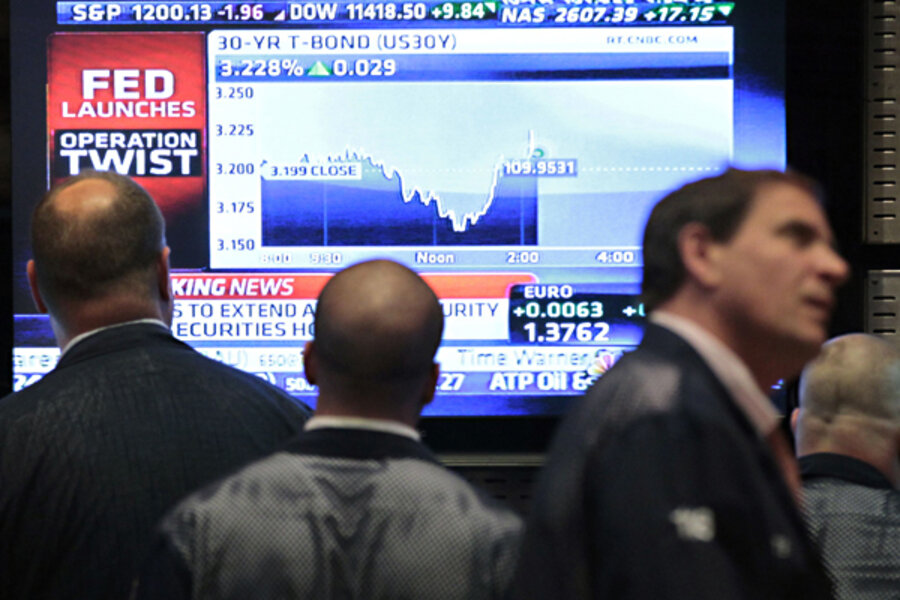Stocks plunge after Fed stimulus announcement
Loading...
| New York
The Federal Reserve did what investors expected — it said it would buy Treasury bonds to help the economy. Stocks then plunged because investors saw a grim forecast behind the Fed's plans.
The Fed said Wednesday it would buy long-term Treasurys and sell short-term ones to help the economy regain momentum. It surprised investors when it said it would include more 30-year bonds in its purchases than expected.
Financial analysts said stocks dropped as investors came to the conclusion that the Fed expects the economy to take years to recover.
"It's being viewed as perhaps an admission that this is a longer-term issue that the U.S. economy is facing and not one that's going to be solved over a couple of years," said Oliver Pursche, president of Gary Goldberg Financial Services.
The major indexes fluctuated as they often do after major Fed announcements. The losses accelerated in the last hour of trading.
The Dow Jones industrial average lost 283.82 points, or 2.5 percent, and closed at 11,124.84. The Standard & Poor's 500 index fell 35.33, or 2.9 percent, to 1,166.76 The Nasdaq composite fell 52.05, or 2 percent, to 2,538.19.
The yield on the 10-year Treasury note fell to a record low of 1.86 percent from late Tuesday's 1.93 percent.
After a two-day meeting, the Fed said it would buy $400 billion in 6-year to 30-year Treasurys by June 2012. Over the same period, it planned to sell $400 billion of Treasurys maturing in 3 years or less. The move is intended to drive down interest rates on long-term government debt, and could lower rates on mortgages and other loans.
Those purchases are intended to send long-term rates down. The inclusion of more 30-year bonds than expected indicated that the Fed sees a need to keep rates lower for an extended period. And that took investors by surprise, Pursche said.
"When the Fed decides to take this type of action, it's because things are serious," Pursche said.
Wednesday's trading recalled the sharp losses the market has suffered this summer as investors feared that the country was heading toward another recession.
The Fed had some bleak remarks about the state of the economy in the statement that accompanied its decision to buy more bonds. The Fed said the economy has "significant downside risks." One of those risks is the volatility in financial markets around the world. It also listed a number of problems that won't be easily solved: high unemployment, a depressed housing market and consumer spending that is growing only at a slow pace.
There are also concerns about problems overseas, including the debt crisis in Europe that investors believe could affect the U.S. The International Monetary Fund said Wednesday the global financial system is in its most vulnerable state since the 2008 financial crisis. In a semi-annual report, the IMF said the risk to banks and financial markets has grown in recent months.
The Fed's new bond buying plan has been dubbed "Operation Twist" because it is designed to "twist" long-term rates relative to shorter ones. The last time a similar program was used was in the early 1960s, when the twist was the rage on dance floors.
This is the third major bond-buying program by the Fed in less than three years.
"That is perhaps a recognition that the Fed is running out of firepower and resorting to some arcane techniques resurrected from the vault of history," said Lawrence Creatura, portfolio manager at Federated Investors.
Investors may also be doubting the Fed's ability to drive down Treasury yields much more from their current levels.
"Let's face it: with a 10-year Treasury offering 1.90 percent, there's not a whole lot of room for there to be a major impact," said Mark Lamkin, the head of Lousiville, KY-based Lamkin Wealth Management.
While initial investor reaction to the decision was negative, it's common for stocks to change direction in the minutes, hours and days following an important Fed announcement, said Phil Orlando, chief equity market strategist for Federated Investors.
"It's not unusual for the market to drop a percent or two after the decision, then it may rally the next day, then it may fall again. People are confused, they don't really know how to settle it in," said Orlando.
___
AP Business Writers David K. Randall and Stan Choe contributed to this report.





